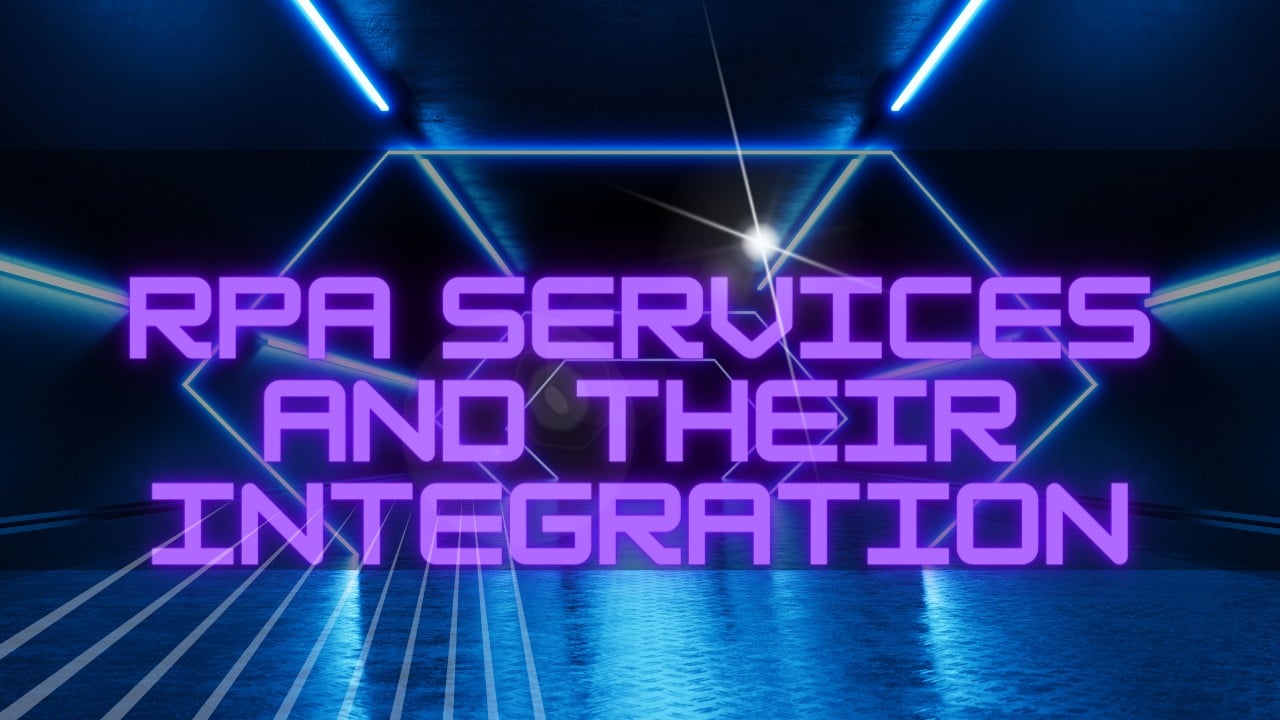This website uses cookies so that we can provide you with the best user experience possible. Cookie information is stored in your browser and performs functions such as recognising you when you return to our website and helping our team to understand which sections of the website you find most interesting and useful.
Understanding the Role of RPA Services in Digital Transformation

In today’s dynamic business landscape, digital transformation is no longer an option but a necessity. Organizations are constantly seeking innovative ways to improve their operations, enhance customer experience, and reduce costs. Robotic Process Automation (RPA) has emerged as a valuable tool for driving digital transformation. In this article, we will explore the role of RPA services in digital transformation.
What is RPA and Its Importance in Digital Transformation
RPA, or Robotic Process Automation, is an emerging technology that is transforming the way businesses operate. It involves the use of software bots to automate repetitive and rule-based tasks, freeing up human resources to focus on more complex and strategic activities. RPA is a critical enabler for digital transformation, as it helps organizations to achieve operational efficiency and agility while reducing costs.
The use of RPA has become increasingly popular in recent years, as businesses look for ways to streamline their operations and increase efficiency. By automating repetitive tasks, RPA allows organizations to reduce errors and improve accuracy, while freeing up employees to focus on more valuable work.
Mobile application development has become increasingly competitive and complex in today’s digital landscape. The role of RPA Services in this domain is paramount. RPA Services offer a range of benefits to mobile app development, including enhanced efficiency, reduced human errors, and accelerated time-to-market. By automating repetitive tasks, RPA enables developers to focus on more strategic aspects, such as user experience and innovation. With RPA’s capabilities, mobile app development teams can achieve faster delivery cycles, higher quality, and improved customer satisfaction. Embracing the role of RPA Services in mobile application development is key to staying ahead in this rapidly evolving industry.
Defining Robotic Process Automation (RPA)
RPA refers to the use of software bots to automate repetitive and rule-based tasks such as data entry, form filling, and invoice processing. RPA bots are designed to mimic human actions, and they can be programmed to perform tasks across multiple applications and systems.
One of the key benefits of RPA is its ability to work across multiple systems and applications, making it a powerful tool for organizations looking to streamline their operations and reduce costs. By automating repetitive tasks, RPA can help businesses to achieve significant cost savings, while also improving accuracy and reducing errors.
Key Benefits of RPA in Digital Transformation
RPA offers several benefits to organizations seeking to drive digital transformation. These benefits include:
1. Improved operational efficiency: By automating repetitive tasks, RPA can help organizations to achieve significant improvements in operational efficiency, freeing up employees to focus on more valuable work.
2. Higher accuracy and quality: RPA bots are designed to mimic human actions, making them highly accurate and reliable. This can help organizations to reduce errors and improve the quality of their work.
3. Reduced costs: By automating repetitive tasks, RPA can help organizations to achieve significant cost savings, reducing the need for manual labor and improving overall efficiency.
4. Enhanced scalability and agility: RPA can be easily scaled up or down to meet changing business needs, making it a highly flexible and agile technology.
Overall, RPA is a powerful tool for organizations seeking to drive digital transformation and achieve operational efficiency. By automating repetitive tasks, RPA can help businesses to reduce costs, improve accuracy, and free up employees to focus on more valuable work. As the technology continues to evolve, it is likely that we will see even more innovative uses of RPA in the years to come.
Role of RPA Services Drive Digital Transformation
RPA, or Robotic Process Automation, is a powerful tool for driving digital transformation and enabling organizations to stay ahead of the curve. By automating manual and repetitive tasks, RPA helps to streamline business processes, enhance customer experience, reduce operational costs, and improve compliance and risk management. In this article, we will explore these benefits in more detail.
The role of Robotic Process Automation (RPA) in app development is paramount. RPA offers a game-changing approach to streamline and automate repetitive tasks in the app development lifecycle. By leveraging RPA technologies, developers can enhance productivity, accelerate development cycles, and ensure consistent quality throughout the process. RPA empowers app development teams to automate code generation, testing, deployment, and maintenance, enabling them to focus on more strategic and creative aspects.
Streamlining Business Processes
One of the key benefits of RPA is its ability to streamline business processes. By automating tasks that are manual and repetitive, RPA reduces errors and improves efficiency. This enables organizations to achieve faster turnaround times, better quality, and higher productivity. For example, RPA can be used to automate data entry, invoice processing, and report generation, freeing up employees to focus on higher-value tasks.
Moreover, RPA can be integrated with other technologies such as Artificial Intelligence (AI) and Machine Learning (ML) to further enhance business processes. For instance, RPA can be used to collect and analyze data, enabling organizations to make data-driven decisions and identify areas for improvement.
Enhancing Customer Experience
Another significant benefit of RPA is its ability to enhance customer experience. By automating tasks such as customer onboarding, order processing, and query resolution, RPA can help organizations to provide a seamless customer experience. This results in faster response times, higher customer satisfaction, and increased loyalty.
For example, RPA can be used to automate the process of customer onboarding, ensuring that new customers are quickly and efficiently onboarded. RPA can also be used to automate order processing, ensuring that orders are processed accurately and efficiently. Additionally, RPA can be used to automate query resolution, ensuring that customer queries are addressed in a timely and efficient manner.
Reducing Operational Costs
Another significant benefit of RPA is its ability to reduce operational costs. By automating manual and repetitive tasks, RPA can significantly reduce labor costs, improve productivity, and increase efficiency. This enables organizations to achieve cost savings that can be reinvested in other areas of the business.
For example, RPA can be used to automate the process of data entry, reducing the need for manual data entry and freeing up employees to focus on higher-value tasks. RPA can also be used to automate invoice processing, reducing the need for manual invoice processing and improving efficiency. Additionally, RPA can be used to automate report generation, ensuring that reports are generated quickly and accurately.
Improving Compliance and Risk Management
Finally, RPA can help organizations to improve compliance and risk management. By ensuring that processes are executed consistently and accurately, RPA can help organizations to comply with regulations and mitigate risks. This is particularly important in industries such as finance, healthcare, and insurance, where compliance and risk management are critical.
For example, RPA can be used to automate tasks such as fraud detection and prevention, ensuring that fraudulent activities are detected and prevented. RPA can also be used to automate compliance checks, ensuring that processes are executed in accordance with regulations and policies.
RPA Services and Their Integration with Other Technologies

RPA can be integrated with other technologies such as Artificial Intelligence (AI), Machine Learning (ML), and Internet of Things (IoT) to achieve even greater benefits.
RPA and Artificial Intelligence (AI)
Combining RPA with AI can enable organizations to automate more complex tasks such as natural language processing and image recognition. This results in higher accuracy, faster decision making, and improved customer experience.
RPA and Machine Learning (ML)
RPA and ML can be used together to create intelligent automation solutions. ML algorithms can be used to train RPA bots to recognize patterns and make decisions, resulting in higher productivity and accuracy.
RPA and Internet of Things (IoT)
RPA can be used to automate tasks in IoT applications such as smart factories, resulting in higher efficiency and lower costs. RPA can also be used to analyze data from IoT devices to identify patterns and make predictions, resulting in improved decision making.
Implementing RPA Services in Your Organization
Implementing RPA services in your organization requires careful planning, execution, and monitoring. Robotic Process Automation (RPA) is a technology that allows organizations to automate repetitive and rule-based tasks by using software robots. This technology has gained popularity in recent years due to its ability to improve operational efficiency, reduce costs, and increase accuracy.
However, implementing RPA services in an organization is not a simple task. It requires a well-planned strategy and execution plan to ensure a successful implementation. In this article, we will discuss some of the key factors that organizations should consider when implementing RPA services.
Identifying the Right Processes for RPA Implementation
Organizations should identify the right processes that are suitable for RPA implementation. These processes should be manual, repetitive, and rule-based. This means that they should involve a high volume of repetitive tasks that follow a set of predefined rules. Examples of such processes include data entry, invoice processing, and report generation.
Identifying the right processes for RPA implementation is crucial to ensure the success of the implementation. Organizations should conduct a thorough analysis of their processes to identify those that are suitable for automation.
Choosing the Right RPA Tools and Vendors
Organizations should choose the right RPA tools and vendors based on their specific requirements, budget, and scalability needs. There are many RPA tools and vendors available in the market, and selecting the right one can be a daunting task.
Organizations should consider factors such as the ease of use, scalability, security, and cost when selecting an RPA tool. They should also evaluate the vendor’s reputation, experience, and customer support services.
Developing an RPA Implementation Roadmap
Organizations should develop a comprehensive roadmap for RPA implementation that includes planning, design, testing, deployment, and maintenance. This roadmap should outline the steps involved in the implementation process and provide a timeline for each step.
The planning phase involves identifying the processes that are suitable for automation and selecting the right RPA tool and vendor. The design phase involves creating the automation workflows and defining the rules that the software robots will follow. The testing phase involves validating the automation workflows and ensuring that they meet the desired outcomes. The deployment phase involves rolling out the automation workflows to the production environment, and the maintenance phase involves monitoring and optimizing the automation workflows.
Measuring the Success of RPA Implementation
Organizations should measure the success of their RPA implementation by tracking key metrics such as cost savings, productivity gains, and customer satisfaction. Cost savings can be measured by comparing the cost of manual labor to the cost of RPA implementation. Productivity gains can be measured by comparing the time taken to complete a task manually to the time taken to complete the same task using RPA. Customer satisfaction can be measured by collecting feedback from customers on the quality of service provided.
Measuring the success of RPA implementation is crucial to ensure that the implementation is delivering the desired outcomes and to identify areas for improvement.
In conclusion, implementing RPA services in an organization can be a complex process that requires careful planning, execution, and monitoring. By identifying the right processes, selecting the right RPA tools and vendors, developing a comprehensive implementation roadmap, and measuring the success of the implementation, organizations can ensure a successful implementation of RPA services.
Conclusion
Role of RPA Services are a critical enabler for digital transformation. By automating repetitive and manual tasks, RPA helps organizations to achieve operational efficiency, agility, and cost savings. RPA can be integrated with other technologies such as AI, ML, and IoT to achieve even greater benefits. Organizations should carefully plan their RPA implementation and measure its success to ensure that they achieve their desired outcomes.



